

Staying Home with CVI

Jonathan Graves
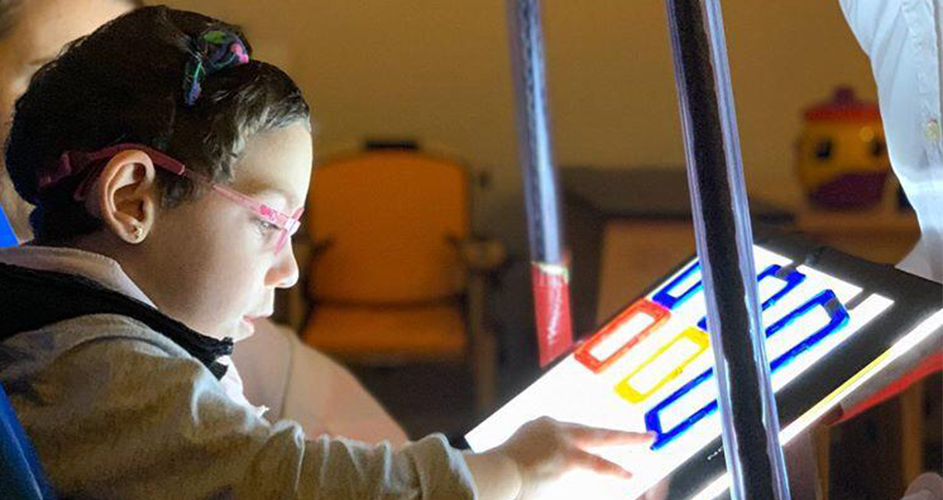
This article is part of a continuing series about Cortical Visual Impairment.
As many children are now spending time with their families at home, parents of children with CVI may be seeking ideas for activities to do at home with their little ones. One powerful resource for this is your child’s CVI schedule, which should provide ideas for accommodations that will allow all the activities of their day to be visually accessible. If your CVI schedule has been designed by your TVI or vision professional to accommodate their school day, you may be able to develop some of your own accommodations using what you know about your child’s CVI Range score and the kinds of support they receive in other activities. All of the CVI characteristics are important, but the characteristics we can have the most control over at home are:
- Color – Use bright colors when possible, especially your child’s preferred color
- Light – Add light with a flashlight, task light, or light tablet, and reduce competing light sources when possible
- Movement – Add movement to the target your child should attend to by wiggling it slightly when presenting, or by adding reflective materials that will simulate movement
- Complexity – Present a limited number of objects at a time, and choose objects without a complex surface pattern. Reduce auditory distractions during visual activities.
- Latency – Allow your child time to “find” and consider the object you are presenting.
- Novelty – Choose objects with characteristics that make them similar to other objects your child is already familiar with, such as using the same type and color of tape to mark things or places we want them to reach for.
- Distance – Control how far away the child is from the target object, and therefore how much of the background complexity also needs to be considered.
Your child’s CVI Schedule should be customized to their daily routine, but many schedules for young children contain some of the following activities:
Mealtimes – The child should have a routine in place to promote visual attention to their bowl, plate, spoon or fork, and cup. If she cannot feed herself, keep her food in a bright bowl she can see, and promote attention to the bowl with light from above using a task lamp, or below using a light box or tracing tablet. If she is working on feeding herself, place their bowl on an artist’s tracing tablet to help with backlighting. (Many tablets are fairly sealed; you can cover any parts which shouldn’t get wet using electrical tape.) Finally, give her the opportunity to see her bottle or cup by adding light from a flashlight beneath it and allowing extra time for her to reach and grasp the cup if this is a skill she is working on.
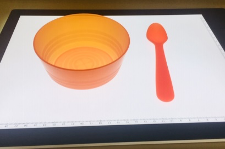

Getting Dressed – The child may want to share his or her opinion about what to wear in the morning. Present two shirts side by side and spaced slightly apart in front of a neutral or dark background, and give her a chance to view them both. Select shirts that have bright color, but without a complex pattern. Some shirts even include reflective materials which make them easy favorites. If attending to two or more objects is difficult for the child due to complexity of array, begin by presenting each shirt by itself and describing the choices after she has looked, then present them side by side for consideration. She may make a choice by looking at one for a long time, or by reaching.
Handwashing – Such a relevant topic! Make handwashing a visual task by adding bright color to the most important elements in the task—the faucet handle, the soap dispenser, and the towel. Make these objects stand out by decreasing the clutter on the counter aside from these objects. This might be easiest to accomplish in a guest bathroom or powder room, which may be set up with very few objects on the counter. Like with all children, it may be helpful to add a song or rhyme to the handwashing routine, but add in quiet time for the child to take part in finding and reaching for the water, soap and towel. (In this picture, the green soap glows slightly from a flashlight backlighting the clear bottle, and the faucet handle has red tape to mark it. Since the mirror adds complexity, a small piece of black cardboard simplifies the scene.)
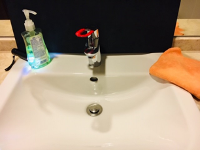
Bath time – A tub full of water provides great opportunities for visual attention because it creates movement and reflects light. Try adding lighted bath toys or very bright toys to the water, and give the child a chance to visually attend to and reach for slow moving bath toys. Additionally, you can use a brightly colored washcloth, which will help him understand where he will feel the washcloth next.
Play with siblings – One of the greatest benefits to a child with CVI is a sibling who can provide peer modeling and interaction in a unique way. Older siblings can learn the basics of how to present toys for their brother or sister, including bringing out one toy at a time, and using movement and light to attract attention. Siblings can help model turn-taking and support anticipatory games, such as building a tower and knocking it down.
Light box activities – If you use a light box at home, you can make a Squishy Bag that your child can play with on the light box. You will need a large Ziploc bag filled with hair gel and glitter, with a few drops of food coloring in the child’s preferred color. The bag has an interested texture when squished, and creates swirls of brighter color as the child pushes down on the bag. (More information about the squishy bag can be found at Paths to Literacy.)
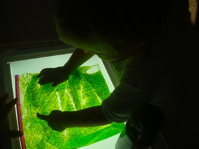
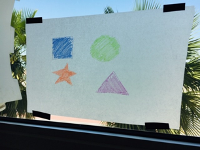
Window drawings – If you don’t have a light box or tablet (or even if you do) one fun art activity is drawing or coloring on paper taped to the window, which allows for a backlit effect. This works really well with paper on a large roll, which can cover a wide area and reduce complexity from movement or objects on the other side of the window. You can also use baking parchment paper which lets in more light. Have the child choose his color by presenting two choices against a black background. You can draw shape outlines and ask him to fill in using the matching color.
Treasure hunting – One way to help work on visual complexity at home is to “hide” several similar objects around the room and ask the child to find and collect them. This promotes exploration and movement, visual curiosity, connecting vision to reaching and grasping, and independence. Hide similar objects in a room with support based on complexity. To make objects easier to find, place them with nothing around them, against a dark background. You can even add light to the objects with a small flashlight that remains on for the duration of the activity. To increase complexity, remove the light. For children who can find the objects in a simplified visual field, make the activity more challenging by adding one or two objects around the “hidden” object.
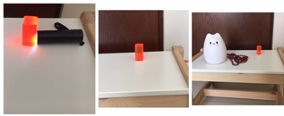
Children with CVI learn by using their vision in functional routines throughout the day as often as possible. You can support them by making these routines visually accessible using accommodations in your child’s CVI schedule. The more opportunities they have to visually attend to these important routines, the more familiar and meaningful they become.
Dr. Christine Roman Lantzy has written a great article with a few additional ideas for children with CVI:
For more information about CVI and CVI schedules, feel free to contact Jonathan at jgraves@highhopesdubai.com.


